» live score / detailed description
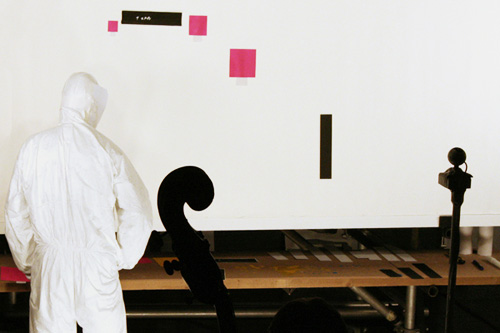
Introduction
The installation is based on the idea of score as an instrument for notation and schematic representation of the musical composition and replies to its 20th century´s development suggesting its new form - the score which sounds and is created in real time.
Interface of the "Live Score" is a big sheet of paper which is connected through a webcam with color-motion tracking system what analyzes the performer´s action. Working with sprays and stencils, bubbles, balloons and other suprising medias performer Tomas Vanek is able to record, structurise, deconstruct - simply operate the musical composition.
"Live Score" is a communication tool for everybody who is present on the performance - for musicians and artists but mainly for audience which can get in this way better understanding and unique experience of music.
Installation is presented trough our performances. General idea of the Live Score is very opened. Not only the installation is being constantly developed as we are getting new ideas how to manipulate with the physical interface of the score but also musical content and generally concept of the performance is changing as we are trying to experiment with different contexts of this work.
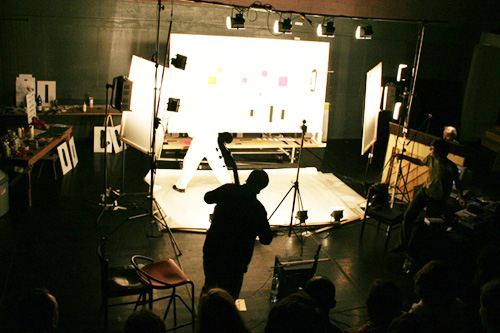
The Performance
The performance use to have two main parts. The first part is based on the concert of the discretionary musical project (invited musical group or individual which use to be connected with the place where we are making the performance). The music from the concert is live-sampled via Live Score and after used as source of improvisation in the second part of the performance.
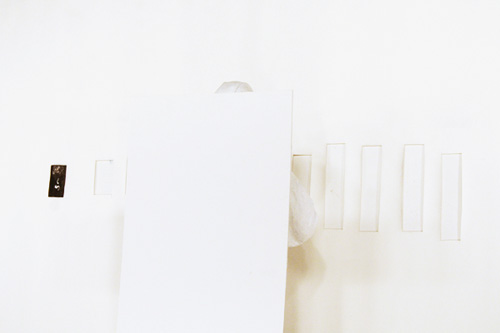
To speak more in concrete while the concert of the "invited band" is in progress Tomas Vanek is sampling sound fragments of their performance into paper objects. Using sprays he creates black vertical rectangles which (when detected by the webcam) triggers the recording for certain time.
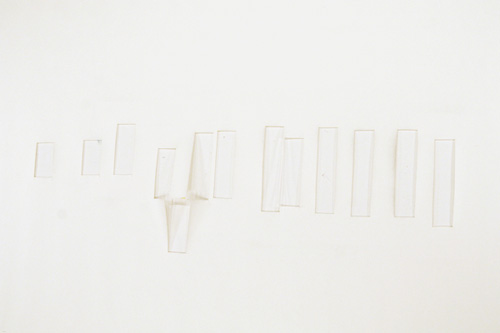
The recorded sample is identified and connected with the painted object - not only for the computer but also in the audience´s mind: Sprayed rectangles differs in size and also Vanek customised each rectangle by giving it description - either gestical (reference to the graphical score) or typographical. After each song he cut out the painted object from the big sheet of paper and took it for the last part of the performance.
In the last main part we were creating our own reinterpretation based on samples recorded in previous parts of the performance but also on live improvisation of the additional performing musician: Via Live Score Vanek can play collected samples from previous part of the performance (previously cut rectangles can be played if they are put horizontaly on the Live Score), live sample and play new ones (here again recording is performed by vertical black rectangles) - and all of this can be manipulated trough other visual objects and actions (colourfull objects - pink squares, yellow squares, bubbles etc) creating musical electronic deconstrucion in real time. The result is new interpretation of the songs, unique musical compositions which create the performance always totally different.
Basic Principles of the Score
Interface of the "Live Score" is based on two basic kinds of objects: "sound objects" and "effect objects". These two groups are also easily identifiable by their colours - sound objects are black, effect objects are colour based.
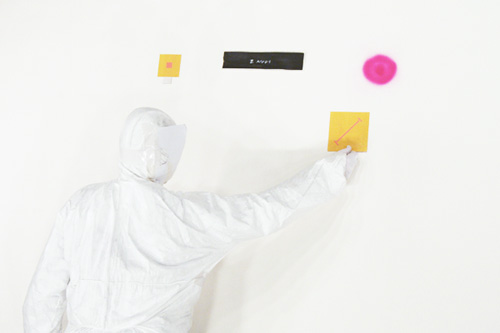
Sound objects:
Vertical rectangles always stand for sampling: In the preliminary parts of the performance (concert of the song´s previous versions) vertical rectangles work simply as sampling tools. By spraying a rectangle the performer triggers a sampling of live music for certain time and this sound fragment is automatically saved into the hard disc of the computer. In the last part of the performance (our electronic reinterpretation through the "Live Score") vertical rectangles are used as typical live sampling objects. There are musician who improvis live. By spraying the vertical rectangles the musical instruments are recorded and sample is immediately being played back into the composition.
Horizontal rectangles are the "playing objects". They work as sound players for the samples which were recorded in the previous parts of the show.
Effect objects:
Pink squares (and all the other objects) represent the effects which influence the quality of sound. Yellow squares represent the manipulation with loops.
The system is based on analysis of the relationship between sound objects and effect objects (effects influence the sound).
In this way big amount of information can be compressed into relationship of few objects.
The system is measuring distance between the sound objects and the effect objects. For example - let say we have two objects: a pink square representing reverb effect and a rectangle representing the sound. Intensity is dependent on the distance between the sound object and the effect object. So if the pink square is very close to the sound object, the sound will be very much in reverb, more far it is from the sound object the reverb looses its intensity until the certain point when the pink square is out of the "influence area" and doesn´t influence the sound at all. In a way it is metaphor to solar (gravitational) systems where planets (effects) are kept in the relation to the suns (sounds). (Please see enclosed Figure too).
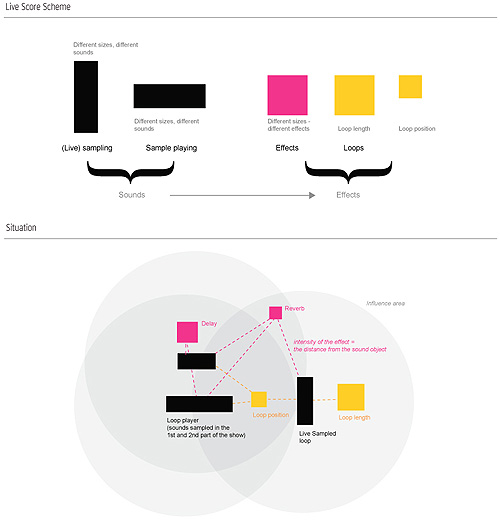
Many other medias (like freely sprayed spots, lines, bubbles, decoulages) disconcert the basic scheme and brings other sound configurations.
Reflections
One of the main topics of this work is creativity and aim to mediate process of creation for the audience. The Performance based on Live Score could be hardly called "concert, or theatre show". It is more like some open laboratory space where audience can become part of the unique moment of creation. As we are trying to be closed to this moment everything is opened, Which means, nothing is trained into final form, every improvisatoin is always different, so something new is being created something new always happen. Even "unsucessfull" parts are good for the performance as whole as they can uncover the structure of the score and therefore musical principles in general.
Live Score is very multilayered kind of work bringing different meanings in different contexts. For the instrumentalists (musicians) it is great communication tool which they can use for the live improvisation and also an object which can bring better understanding of music - its form, emotions and structure. For people who work with interface design could be interesting how unique algorithm can reduce big amount of information into simple composition of few objects. For people from art context there are more different meanings. On one hand our work is truly postmodern (working with hyperstructure, recyclation of the material, contemporary technological context etc.) on the second hand it could be viewed as restitution of moderna (constructivistic nature of the score schema, work with aleatoric). In the end it is important that people have to deal with the other aspects of the work then it is their own focus.
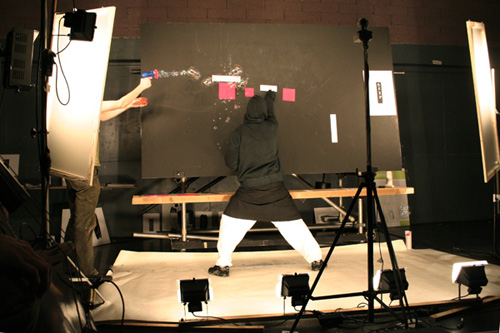
For me as an author there are other things I would like to mention. I was very interested in the material nature of the installation. There were more reasons for this. First of all there is reference to the graphical scores which we wanted to be somehow close to. It is also important that the technology is somehow hidden behind the things, it doesn´t want to fascinate by its futurism so people can more focus on the real meaning of the things. Moreover I was interested in open possibilities of the "real word", possibility to imediatelly experiment with some new ideas in the frame of sheet of paper. In the end it was most important that we found meanings which are not possible to be made in the "virtual reality" of the computers and therefore bring different experience for the audience.
In the end I would like to mention my function in the whole work. As musician I am creating composition in very traditional way. In my multimedia works I am trying to work little bit different. Often i am trying to create frame for the other peoples or processes then authorially supervising (finalise) the work. In my older work "Crossroad" there were cars which created the final musical composition, in another work RGB it was participation with the audience. In this work it is collective of the people from very different contexts who have to communicate together to create the final result. This point emphesizes another aspect of my work which I see very important. We are living in the world which is critically separated into different fields. Not only artworld is isolated from the rest of the society but also different domains of art are isolated. Therefore I often see my role as kind of of bridge or glue for the different domains of art - some kind of tool which could possibly little bit erase this differencies.
<-- back to the project page
|